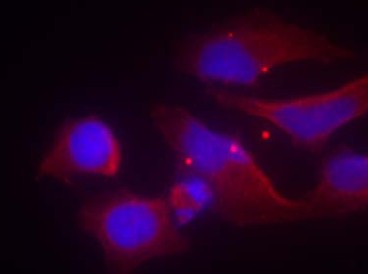NMDAR2B (GRIN2B) pTyr1474 Rabbit Polyclonal Antibody
Other products for "GRIN2B"
Specifications
| Product Data | |
| Applications | IF |
| Recommended Dilution | Immunofluorescence: 1/100 - 1/200. |
| Reactivities | Human, Mouse, Rat |
| Host | Rabbit |
| Clonality | Polyclonal |
| Immunogen | Synthesized phosphopeptide derived from human NMDAR2B around the phosphorylation site of Tyr1474 (H-V-YP-E-K) |
| Specificity | NMDAR2B (phospho-Tyr1474) antibody detects endogenous levels of NMDAR2B only when phosphorylated at Tyr1474. |
| Formulation | Phosphate buffered saline (without Mg2+ and Ca2+), pH 7.4, 150mM NaCl, 0.02% sodium azide and 50% glycerol State: Aff - Purified State: Liquid purified IgG |
| Concentration | lot specific |
| Purification | Affinity-chromatography |
| Storage | Store the antibody at -20°C. Avoid repeated freezing and thawing. |
| Stability | Shelf life: one year from despatch. |
| Gene Name | Homo sapiens glutamate ionotropic receptor NMDA type subunit 2B (GRIN2B) |
| Database Link | |
| Background | NMDA receptors are a class of ionotropic glutamate receptors. NMDA receptor channel has been shown to be involved in long term potentiation, an activity dependent increase in the efficiency of synaptic transmission thought to underlie certain types of memory and learning. NMDA receptor channels are heteromers composed of the key receptor subunit NMDAR1 (GRIN1) and 1 or more of the 4 NMDAR2 subunits: NMDAR2A (GRIN2A), NMDAR2B (GRIN2B), NMDAR2C (GRIN2C), and NMDAR2D (GRIN2D). GRIN2B may be a candidate gene for the neurodegenerative disorder dentato-rubro-pallidoluysian atrophy (DRPLA). Properties of NMDAR include modulation by glycine, inhibition by Zn2+, voltage dependent Mg2+ blockade and high Ca2+ permeability. The involvement of NMDAR in the CNS has become a focus area for neurodegenerative diseases such as Alzheimer's disease, epilepsy and ischemic neuronal cell death. |
| Synonyms | GRIN2B, NMDA Receptor 2B |
| Reference Data | |
| Protein Families | Druggable Genome, Ion Channels: Glutamate Receptors, Transmembrane |
| Protein Pathways | Alzheimer's disease, Amyotrophic lateral sclerosis (ALS), Huntington's disease, Long-term potentiation, Neuroactive ligand-receptor interaction, Systemic lupus erythematosus |
Documents
| Product Manuals |
| FAQs |
{0} Product Review(s)
0 Product Review(s)
Submit review
Be the first one to submit a review
Product Citations
*Delivery time may vary from web posted schedule. Occasional delays may occur due to unforeseen
complexities in the preparation of your product. International customers may expect an additional 1-2 weeks
in shipping.






























































































































































































































































 Germany
Germany
 Japan
Japan
 United Kingdom
United Kingdom
 China
China



